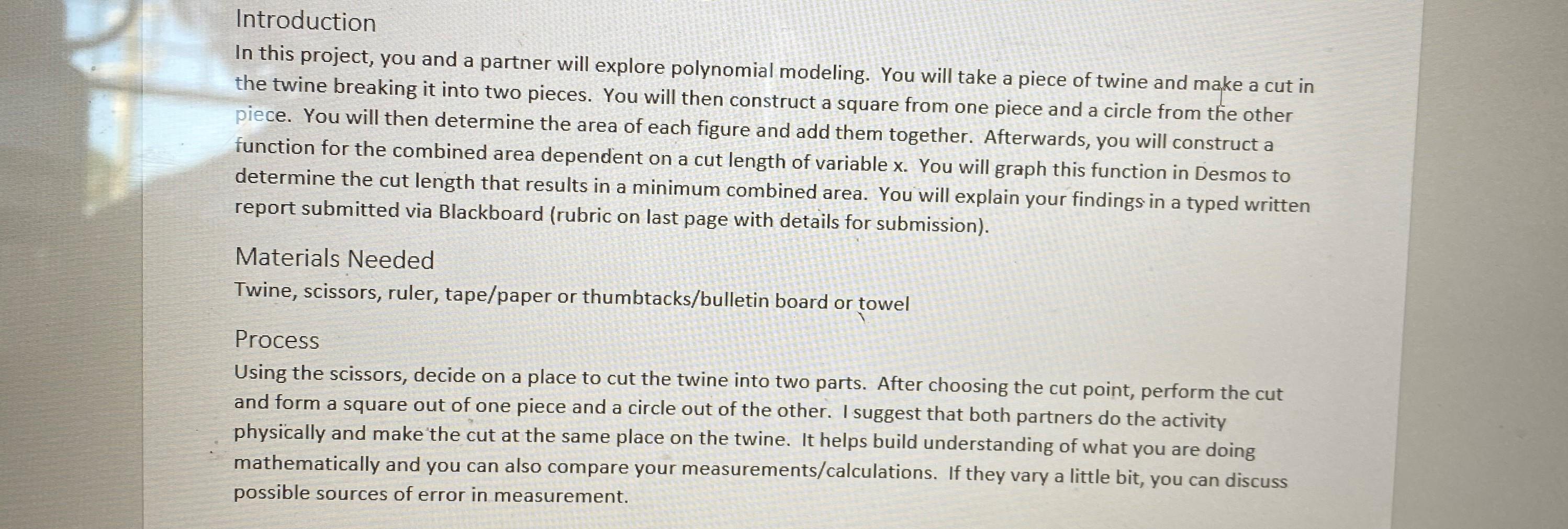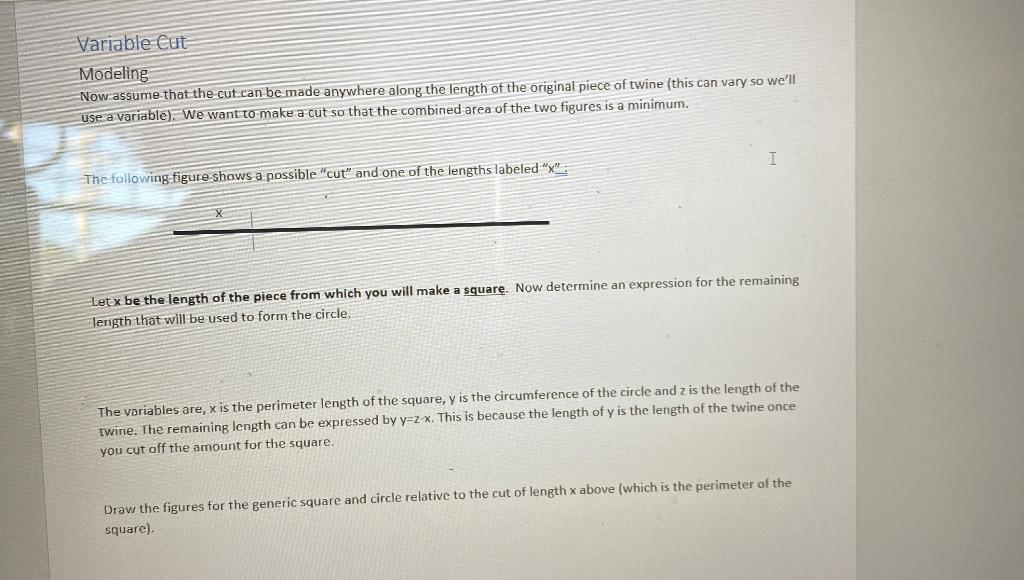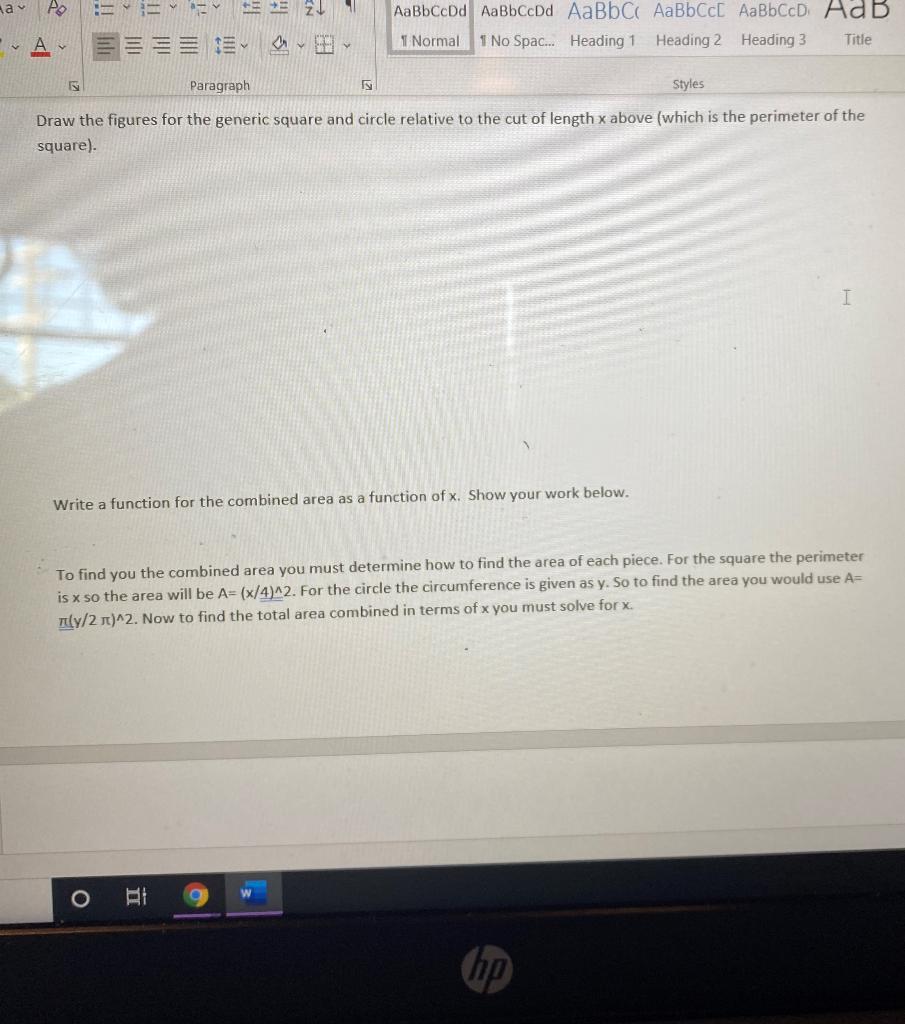Answered step by step
Verified Expert Solution
Question
1 Approved Answer
Hello, please help me with this including the graph as well from demsos or what the graph should look like. due tonight. Thank you. Introduction



Hello, please help me with this including the graph as well from "demsos" or what the graph should look like. due tonight. Thank you.
Introduction In this project, you and a partner will explore polynomial modeling. You will take a piece of twine and make a cut in the twine breaking it into two pieces. You will then construct a square from one piece and a circle from the other piece. You will then determine the area of each figure and add them together. Afterwards, you will construct a function for the combined area dependent on a cut length of variable x. You will graph this function in Desmos to determine the cut length that results in a minimum combined area. You will explain your findings in a typed written report submitted via Blackboard (rubric on last page with details for submission). Materials Needed Twine, scissors, ruler, tape/paper or thumbtacks/bulletin board or towel Process Using the scissors, decide on a place to cut the twine into two parts. After choosing the cut point, perform the cut and form a square out of one piece and a circle out of the other. I suggest that both partners do the activity physically and make the cut at the same place on the twine. It helps build understanding of what you are doing mathematically and you can also compare your measurements/calculations. If they vary a little bit, you can discuss possible sources of error in measurement. Variable Cut Modeling Now assume that the cut can be made anywhere along the length of the original piece of twine (this can vary so we'll use a variable). We want to make a cut so that the combined area of the two figures is a minimum, I The following figure shows a possible "cut" and one of the lengths labeled "x": square. Now determine an expression for the remaining Let x be the length of the piece from which you will make length that will be used to form the circle. The variables are, x is the perimeter length of the square, y is the circumference of the circle and z is the length of the twine. The remaining length can be expressed by y=z-x. This is because the length of y is the length of the twine once you cut off the amount for the square. Draw the figures for the generic square and circle relative to the cut of length x above (which is the perimeter of the square). Po AaBbCcDd AaBbCcDd AaBb C AaBbcc AaBbCD AaB 1 Normal 1 No Spac... Heading 1 Heading 2 Heading 3 Title SED Paragraph Styles Draw the figures for the generic square and circle relative to the cut of length x above (which is the perimeter of the square) I Write a function for the combined area as a function of x. Show your work below. To find you the combined area you must determine how to find the area of each piece. For the square the perimeter is x so the area will be A=(x/4)^2. For the circle the circumference is given as y. So to find the area you would use A= T{y/2 t)^2. Now to find the total area combined in terms of x you must solve for x. w o (hp Introduction In this project, you and a partner will explore polynomial modeling. You will take a piece of twine and make a cut in the twine breaking it into two pieces. You will then construct a square from one piece and a circle from the other piece. You will then determine the area of each figure and add them together. Afterwards, you will construct a function for the combined area dependent on a cut length of variable x. You will graph this function in Desmos to determine the cut length that results in a minimum combined area. You will explain your findings in a typed written report submitted via Blackboard (rubric on last page with details for submission). Materials Needed Twine, scissors, ruler, tape/paper or thumbtacks/bulletin board or towel Process Using the scissors, decide on a place to cut the twine into two parts. After choosing the cut point, perform the cut and form a square out of one piece and a circle out of the other. I suggest that both partners do the activity physically and make the cut at the same place on the twine. It helps build understanding of what you are doing mathematically and you can also compare your measurements/calculations. If they vary a little bit, you can discuss possible sources of error in measurement. Variable Cut Modeling Now assume that the cut can be made anywhere along the length of the original piece of twine (this can vary so we'll use a variable). We want to make a cut so that the combined area of the two figures is a minimum, I The following figure shows a possible "cut" and one of the lengths labeled "x": square. Now determine an expression for the remaining Let x be the length of the piece from which you will make length that will be used to form the circle. The variables are, x is the perimeter length of the square, y is the circumference of the circle and z is the length of the twine. The remaining length can be expressed by y=z-x. This is because the length of y is the length of the twine once you cut off the amount for the square. Draw the figures for the generic square and circle relative to the cut of length x above (which is the perimeter of the square). Po AaBbCcDd AaBbCcDd AaBb C AaBbcc AaBbCD AaB 1 Normal 1 No Spac... Heading 1 Heading 2 Heading 3 Title SED Paragraph Styles Draw the figures for the generic square and circle relative to the cut of length x above (which is the perimeter of the square) I Write a function for the combined area as a function of x. Show your work below. To find you the combined area you must determine how to find the area of each piece. For the square the perimeter is x so the area will be A=(x/4)^2. For the circle the circumference is given as y. So to find the area you would use A= T{y/2 t)^2. Now to find the total area combined in terms of x you must solve for x. w o (hpStep by Step Solution
There are 3 Steps involved in it
Step: 1

Get Instant Access to Expert-Tailored Solutions
See step-by-step solutions with expert insights and AI powered tools for academic success
Step: 2

Step: 3

Ace Your Homework with AI
Get the answers you need in no time with our AI-driven, step-by-step assistance
Get Started


